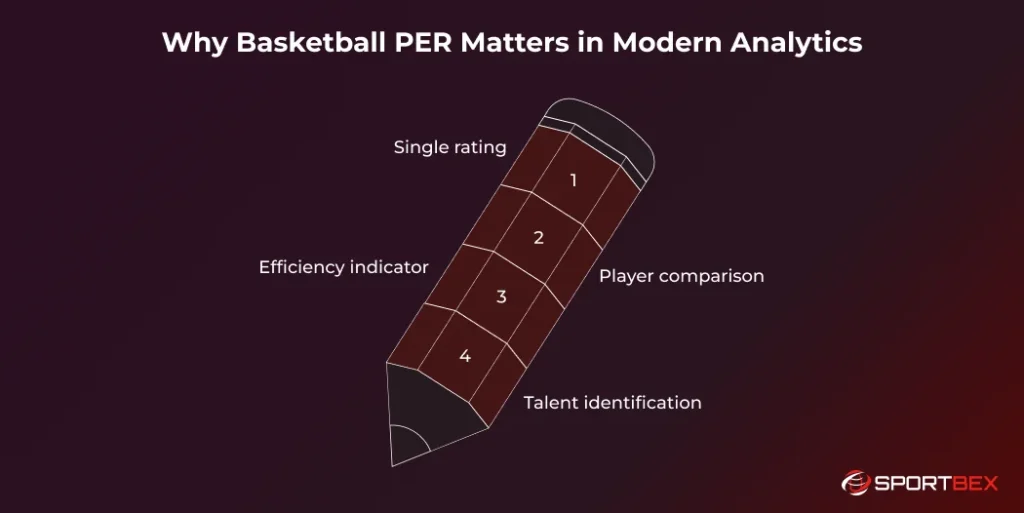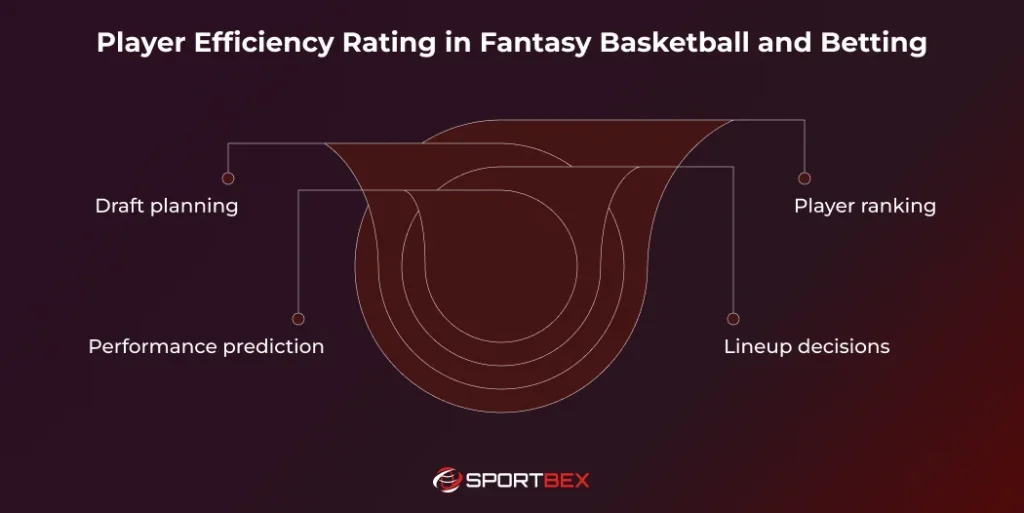Basketball has changed a lot over the years, and one of the biggest shifts has come from the use of data. Today, coaches, analysts, fans, and even developers depend on numbers to understand how well a player actually performs.
The traditional box score tells part of the story, but it doesn’t always show the full impact a player makes on the court. That is why the Basketball Player Efficiency Rating has become such an important tool.
Player Efficiency Rating (PER) is widely used to measure a player’s true contribution in a simple, clear way. Whether you want to study NBA player efficiency rating, compare talent across different basketball leagues, or build a sports app that uses fast and reliable Live Data in Sports, PER helps you see a complete picture of player performance.
The goal of this blog is to explain what PER means, how it works, and why it matters in today’s game. The content is written in easy-to-understand language so that fans, developers, analysts, and anyone curious about the sport can learn how PER helps evaluate players more accurately and fairly.
What Is Player Efficiency Rating (PER) in Basketball?
Basketball Player Efficiency Rating is a simple way to measure how productive a player is during a game. If you have ever wondered what is player efficiency rating, think of it as one number that reflects everything a player does on the court.
PER in basketball was created by analyst John Hollinger. His idea was to build a rating that includes both the good and the bad. Scoring, assists, rebounds, steals, and blocks help the rating go up, while missed shots, turnovers, and fouls bring it down. This makes the metric more balanced and easier to understand.
Today, PER is widely used across the basketball community, especially when people talk about PER in NBA discussions. Fans, analysts, and coaches often rely on PER when comparing players from different teams, roles, or playing styles.
It adjusts for pace, minutes played, and overall involvement in the game. This makes PER a trusted tool for comparing different Basketball Players, whether they are role players or star performers. Understanding PER can help anyone follow the game with more clarity and appreciation.
How Player Efficiency Rating Is Calculated
To understand Basketball Player Efficiency Rating, it helps to know the basic idea behind the calculation. PER was created by John Hollinger to measure a player’s overall impact per minute. The goal was to combine all the things a player does well and subtract the things that hurt the team.
PER starts with all positive stats, including field goals, free throws, three-pointers, assists, rebounds, steals, and blocks. These actions increase a player’s rating. Then, negative stats like missed shots, turnovers, missed free throws, and fouls are subtracted so that efficiency, not just volume, matters.
One of the most important parts of PER is pace adjustment. Teams play at different speeds, so Hollinger added a correction to make the number fair for players from fast and slow teams. This is why PER in NBA comparisons remain reliable across different eras or systems.
The actual formula that produces the rating is called uPER, a detailed equation that includes league averages and team factors. Here is the core structure:
uPER = (1 / MP) *
[ positive actions
– negative actions
+ rebounds, steals, blocks adjustments
– penalty for fouls ]
In the full formula, several extra values help balance everything:
factor = adjusts assists and field goals
VOP = value of a possession
DRB% = defensive rebound percentage
These keep the rating consistent as the league changes. After calculating uPER, the number is adjusted for pace to create the final Player Efficiency Rating.
In short, PER rewards players who contribute efficiently and consistently while reducing the impact of mistakes. This is what makes PER basketball analysis so trusted in modern scouting, comparisons, and performance evaluation.
Why Basketball PER Matters in Modern Analytics

Modern basketball depends heavily on data to make smarter decisions. Teams want clear insights that show how much a player truly contributes on the court.
Basketball Player Efficiency Rating helps because it turns many stats into one meaningful number. Instead of checking scoring, assists, and rebounds individually, PER provides a simple way to understand overall performance.
Single Rating
One major advantage of PER is its simplicity. It combines many different actions such as scoring, passing, rebounding, steals, blocks, and other contributions into one single rating. This makes it easy for anyone to understand a player’s overall productivity without checking long lists of statistics.
Because it works the same way for all players, this single rating is useful across different levels of the game. Whether you’re watching international tournaments or local basketball leagues, PER gives a clear and fair view of performance.
Live Basketball Data, Straight from the Court
A simple, reliable API to power your platform with global basketball data
Player Comparison
Comparing players with different roles or minutes can be challenging, but PER makes the process easier. It uses the same scale for everyone, allowing you to compare rookies, veterans, bench players, and starters without bias.
It also highlights players who impact the game in ways that don’t always appear in the box score. Defensive efforts, ball movement, and smart decisions all affect PER, helping teams recognize players who add real value even if they don’t score much.
Efficiency Indicator
Basketball is not just about scoring points. It is about scoring efficiently. PER captures this by rewarding smart shot selection, strong defense, and balanced overall play. A player who scores efficiently and contributes in multiple areas naturally earns a higher PER.
This makes PER a powerful indicator of a player’s true value. Teams use it to understand who helps them win games consistently. It goes beyond simple numbers and reveals who performs well in different situations.
Talent Identification
PER is also a great tool for spotting hidden talent. Some players may not stand out through highlights, but they show strong PER scores because they contribute in reliable and meaningful ways. This makes PER helpful for discovering underrated players.
Coaches and scouts often use PER to identify rising talent and players who can fit into their team system. It helps track consistency and overall impact, giving a clearer picture of long-term potential.
Player Efficiency Rating in Fantasy Basketball and Betting

Player Ranking
PER is very useful for player rankings because it measures all-around performance. It highlights players who help in many areas like rebounds, assists, and efficiency, even if they’re not top scorers. This makes rankings more accurate and less biased.
Fantasy managers use PER to discover players who consistently add value. It helps identify underrated players who may not be famous but still deliver strong performances every game.
Draft Planning
During drafts, PER helps users choose reliable players early. Instead of picking players only for scoring, managers can build a balanced and stable team by choosing high-PER players. This reduces guesswork and improves long-term results.
PER also makes it easy to find hidden gems. A player who scores moderately but contributes in many other areas can be a smarter pick than someone who only focuses on scoring.
Lineup Decisions
PER makes weekly or daily lineup choices simpler. When two players have similar roles, the one with a higher PER is usually more consistent and efficient. This helps managers decide who to start with more confidence.
It also helps identify which players should be rotated based on matchups. PER gives a clearer idea of who performs well regularly, making lineup adjustments easier.
Performance Prediction
PER is helpful for predicting future performance because it shows consistency. Players with strong PER scores usually maintain good form across different games. This makes them safer options in fantasy leagues and betting.
It also helps users spot players who may rise or fall based on recent trends. Since PER reflects true efficiency, it gives a better picture of who is dependable and who might struggle in tough situations.
Access Complete Basketball Player Information in One Place
Sportbex Basketball API makes it simple to find all important player information in one place. Instead of checking multiple websites for stats like points, assists, rebounds, or shooting accuracy, you can access everything through one reliable source.
Sportbex also provides structured and accurate data that works perfectly with advanced metrics like Player Efficiency Rating. When you have complete stats updated in real-time, PER becomes more meaningful and easier to use.
Having complete data in one place is extremely helpful for fantasy basketball and sports betting. Users can quickly compare players, check recent performances, and identify strong picks based on consistent trends.
With the Sportbex Basketball API powering this information, fantasy platforms and sports apps can offer more accurate predictions and a better overall experience.
For developers, this single source of trusted data makes it easier to build features like leaderboards, player profiles, and analytics dashboards. With Sportbex providing real-time and historical basketball data, apps become faster, more reliable, and more helpful for users.
Conclusion
Player Efficiency Rating has become one of the most useful tools in modern basketball because it turns complex stats into a simple number that anyone can understand. Whether you’re studying NBA player efficiency rating or comparing players from different basketball leagues, PER offers a fair and consistent way to measure real impact.
Fans get a deeper appreciation of player performance, while coaches, analysts, and developers gain accurate data they can trust. From spotting hidden talent to making better decisions in a Fantasy Basketball App, PER continues to shape how people read and understand the sport.
As basketball keeps evolving, PER will remain an important part of analysis. Whether you’re watching games, using a Sports App, or simply tracking your favorite stars, the Basketball Player Efficiency Rating gives you a clearer and more confident view of the game.
Build a Winning Sports Platform
Use our flexible Basketball API for your website, platform, or service.
Frequently Asked Questions
Basketball Player Efficiency Rating is a statistic that measures a player’s overall impact by combining their positive and negative contributions into one simple number.
Basketball Player Efficiency Rating is calculated by adding a player’s positive stats, subtracting their negative stats, and adjusting for pace to create a fair per-minute productivity score.
Basketball Player Efficiency Rating is important because it helps compare players easily, highlights efficiency, and shows who contributes the most in limited playing time.
Yes, Basketball Player Efficiency Rating is considered reliable for comparing NBA players, especially because it adjusts for pace and includes many performance factors.
Absolutely. Basketball Player Efficiency Rating helps fantasy basketball users identify high-value players, plan drafts, and make better lineup decisions.
Recent Blog
What Makes the Cricket Exchange API Valuable for Operators?
November 19, 2025
 9 min
9 min
The Role of Real-Time Data APIs in Horse Racing Prediction
November 19, 2025
 9 min
9 min







